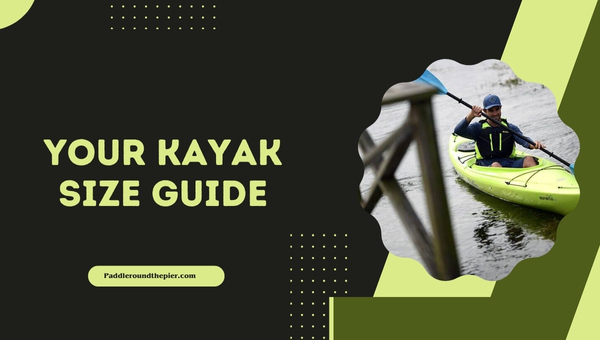Kayak Size Guide: Find Your Perfect Fit Today!
Does the world of kayaking feel like a vast ocean, and you're just a small fish trying to find its way? Welcome aboard! My easy kayak-size guide is here to turn that ocean into a manageable puddle. Whether you're new to this wonderful water sport or a seasoned pro looking for some additional insight, this article is tailored for all.
We'll dive deep into why the size of your kayak matters and how different types play their part, and then we'll answer the big question - what size kayak do I need?
Finding the right-sized kayak is as simple as understanding your needs and functionality. If you're primarily using it for fishing in calm lakes, a wider recreational kayak might be ideal for stability. On the other hand, if traversing fast rivers gets your heart racing, going for longer whitewater kayaks could be best to handle those choppy waves.
What You Will Discover
- Comprehensive kayak size guide made simple
- Unearth secrets behind how to size a kayak
- Make excellent choices with our kayak size recommendations
- Master tips on selecting the ideal kayak size
- Demystify those baffling numbers with our kayak size chart showing how they translate in real life.
Your Kayak Size Guide
Whether you're a kayaking champ or a newbie paddler, the lingering question "What size kayak do I need?" often seems to pop up, and so it should. Understanding your kayak size is essential and critical to your kayaking experience.

Why Kayak Size Matters?
The size of your kayak significantly impacts not only your comfort and ease on the water but also your ability to control and maneuver it effectively. Choosing a redwood-sized behemoth might feel like you're hugging a giant while going for something too small can make you feel like Goldilocks sizing up a baby bear's bed - neither is ideal.
- The bigger the kayak, the harder it may be to control. Quick turns could become feats of Olympian strength.
- A smaller kayak might be easier on the arms, but if it's too small, you risk getting wet every time there's a ripple in the water.
In effect, getting yourself well-acquainted with your ideal kayak dimensions would ensure that your trip downriver doesn't end as an unintended swim.
Understanding Different Kayak Types
Familiarizing yourself with different types of kayaks will also help determine suitable sizes. Here is a run-down on some popular ones:
- Recreational Kayaks: These are usually wider (about 28-34 inches), providing stability, which makes them great for beginners or those who want leisurely jaunts in calm waters.
- Sea Kayaks: Designed with speed in mind for longer distances in open waters, sea kayaks measure about 14-18 feet long and about 20-25 inches wide.
- Touring Kayaks: These can vary widely in dimensions between models - generally falling between 12-16 feet long with widths averaging around 22-26 inches. Stability varies with design, but they usually offer ample storage potential perfect for multi-day trips!
Also Read: Discovering the Basic Parts of a Kayak | A Definitive Guide
Factors to Consider When Sizing a Kayak
When you're venturing out into the world of kayaking, the "Kayak Size Guide" can seem like an overwhelming maze. However, it breaks down to three essential factors: your body size and weight, your skill level, and the type of activity you plan on doing.
Paddler's Body Size and Weight
When I was selecting my kayak size, I quickly realized that body size and weight play a pivotal role. A common misconception is that any kayak would fit any paddler - but that's far from true. The fact is kayaks differ significantly in terms of their carrying capacity (often indicated as maximum user weight) and cockpit size. Here's how these two aspects can affect your kayaking experience:
- Carrying Capacity: Every kayak has a maximum weight it can carry without affecting its performance or safety. If you're on the heavier side or are planning on bringing along gear or a furry friend, consider looking for a kayak with a larger carrying capacity.
- Cockpit Size: Your ease of entry into and exit from the cockpit greatly depends on its dimensions. Being unable to fit inside the cockpit comfortably won’t just make for an unpleasant ride; it could risk capsizing.
Skill Level
Your experience level quite frankly influences your choice while following a 'kayak size guide.' While beginners might lean towards wider, more stable kayaks (they are less likely to tip), seasoned paddlers may prefer narrow boats that offer speed and are responsive when steering.
- Beginner/Novice: As they’re just starting, beginner paddlers typically need stability over style - therefore broader models work best.
- Intermediate: Those with some experience under their belt might start prioritizing speed alongside stability. Boats with medium width offer this balance.
- Advanced/Expert: Once well-versed in the sport, many paddlers prefer sleek, narrow kayaks that afford speed and agility.
Purpose/Activity Type
How you intend to use your kayak greatly impacts the size and type. Your choice for a serene day out fishing on a calm lake would significantly differ from an adrenaline-filled afternoon of whitewater rafting.
- Recreational Kayaking: These are usually broader, providing more stability - an ideal choice for beginners or casual paddlers.
- Sea or Touring Kayaking: Sea kayaks are longer to handle waves better and offer storage space for overnight equipment.
- Whitewater rafting: Whitewater kayaks are small and agile to navigate rapid river waters effectively.
- Fishing: Fishing kayaks often come with rod holders and accessory mounts, with higher stability to fish safely.
Also Read: How to Store a Paddle Board Effectively: Essential Guide
How to Choose the Right-Sized Kayak?
Before you paddle out in your kayak, it's crucial to know you've got the right size for you and your adventure. There are three main components to consider: length, width, and cockpit size. Let's dive into each!

Deciding on Length
When it comes to kayak size guides, length plays a significant role. Fine-tuning the length of your kayak can profoundly impact its performance in several ways:
- Stability: A longer kayak might feel a bit shaky at first due to its narrowness, but don't let that discourage you! You'll find these models are surprisingly stable in choppy water because they disperse wave energy along their length.
- Tracking: Tracking refers to a kayak's ability to maintain a straight line when paddling. Longer kayaks excel at this - they keep you on the path with fewer corrections required.
- Speed: When racing against the current or covering great distances, every inch of your vessel counts. Because of their long bodies, these kayaks cut through water more efficiently, saving you both energy and time.
Following this advice will help boost understanding of how to size a kayak based on length.
Understanding Width
Next up is understanding width in our comprehensive kayak size chart. And it's no less important than length:
- Initial Stability: Shorter and broader kayaks offer superior initial stability (i.e., steadiness while stationary or moving slowly). So if fishing from your boat is paramount or just starting with kayaking – go wider!
- Maneuverability: Wider vessels turn easier since there's less friction between them and the water surface. This is crucial when navigating tighter spaces like marshlands or rivers.
- Speed Vs. Strength Tradeoff: Slimmer models slide through the water faster; however, they require greater strength and technique not only for maneuvering but also for maintaining balance.
Taking width fully into account is a critical part of selecting the ideal kayak size.
Importance of Cockpit Size
If we're talking about finding the perfect kayak dimensions, we can't ignore the cockpit. Here's why you should care:
- Safety: A snug-fitting cockpit allows for better control over your vessel and ensures you can get out quickly if needed (a crucial aspect especially in whitewater kayaking).
- Comfort: Imagine spending hours in a tight space; wonder how long that trip will stay fun? Make sure your legs fit comfortably and you're able to enter and exit the cockpit efficiently.
- Weather Conditions: Wider kayaks let more water splash inside so considering your route’s conditions when choosing the right kayak size is always wise.
By applying these pointers from our kayak size recommendations, you’ll be well on your way to choosing a kayak that's comfortable, safe, and perfectly suited to both your body and your kayaking adventures!
FAQs
Is there a standard size for kayaks?
There's no one-size-fits-all when it comes to kayaks. Kayak sizes vary widely depending on their purpose, including factors like the weight and height of the paddler, the type of water they will be used in, and the specific activity they are designed for.
Can a heavier person use a small kayak?
It may not be a safe or comfortable experience. Heavier individuals need larger kayaks that can adequately support their weight. The wrong kayak size could compromise its stability or even risk capsizing.
Is it better to get a bigger or smaller kayak than my exact fit?
Your comfort and safety should be your utmost priority while choosing your kayak size. An oversized kayak may compromise control, while an undersized one might lack stability. Always aim for the perfect fit through proper sizing based on your body type, skill level, and intended use.
Conclusion
After diving so deep into the world of kayaking, it's clear that understanding the size and dimension of a kayak is crucial. This "kayak size guide" is your roadmap in helping you pick the best-sized kayak, whether you're a beginner or an experienced kayaker.
Remember, each aspect - from length to width to cockpit size - plays an integral role in determining stability, maneuverability, and speed. Don't forget to consider factors like your body weight and the ultimate purpose of your kayaking adventure!
Key Takeaway Points
- The right size kayak enhances comfort and control.
- Kayak types come in different sizes.
- Your body size, skill level, and activity type influence what kayak size you need.
- Length affects stability, while width impacts strength/speed.
- Cockpit dimensions can influence safety.
